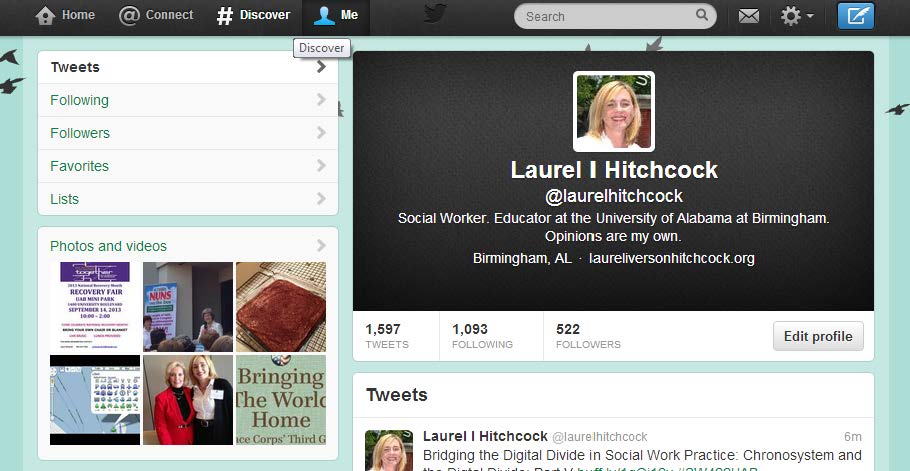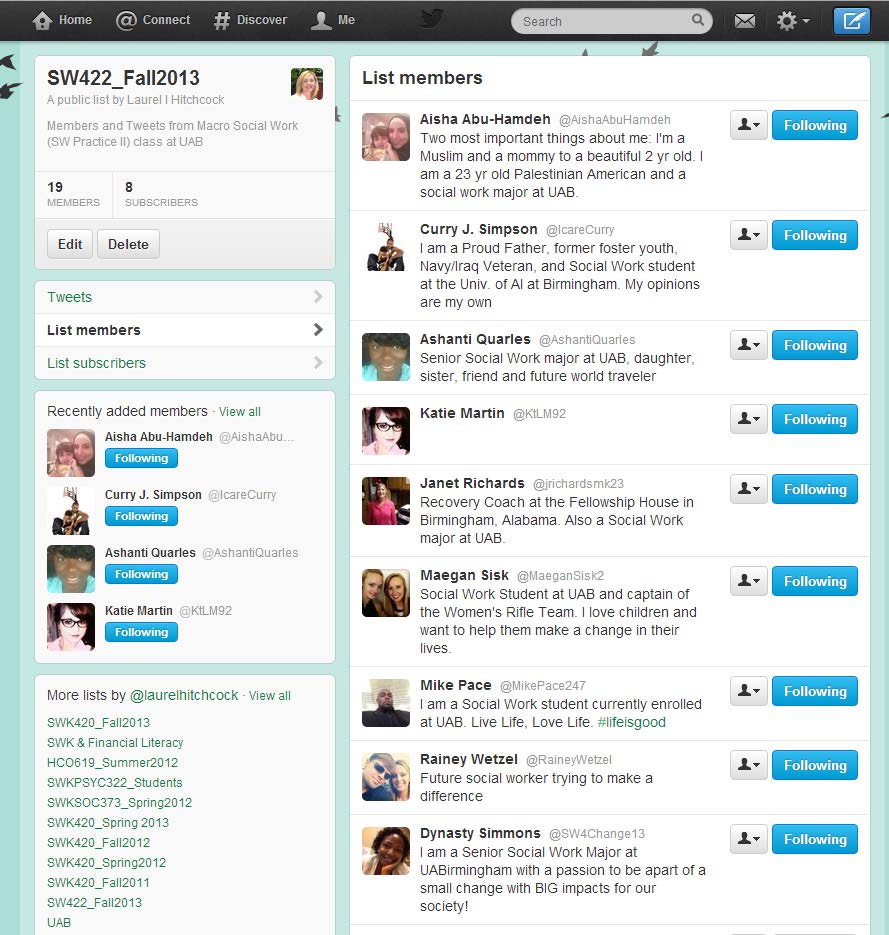Low-Stakes Twitter Assignment for Social Work Educators
A little over two weeks ago, Dr. Jimmy Young (@JimmySW) of the University of Nebraska Kearney and I presented at Council on Social Work Education’s (CSWE) Annual Program Meeting in Dallas, TX about the basics of Twitter and how to do a live or real-time Twitter Chat. Click here to find out more about this presentation. Although it went smoothly, doing a live Twitter Chat in front of a live audience was stressful, and is probably one of the more complicated ways to use Twitter in the classroom. This got me thinking about all the low-stakes ways that social work educators can use Twitter in the classroom to engage students and promote knowledge building and skills development. I have been using Twitter in my undergraduate social work courses since 2011, and have written two blog post about why I think Twitter is a valuable learning tool for students (see How I learned to stop worrying and love Twitter, Part 1 and How I learned to stop worrying and tweet, Part 2). Over time, I have developed a boilerplate assignment that is easily adaptable to different types of courses or even already existing assignments. For this post, I will describe the different parts of this assignment, and connect each part to CSWE’s current social work competencies:
1. Create a Twitter Account for Professional Use: Twitter is free and easy to use. At the beginning of the semester, I ask students to sign up for Twitter account, stressing that it will be used for professional purposes. It has been my experience that most social work students are not familiar with Twitter so I show them how to sign-up for an account. I also share online resources about how to create an account, how to use it, and how the platform works. My favorite resources include Twitter’s Help Center and a blog post titled Twitter 101 written by Dr. Nancy J. Smyth (@nysmyth) of the University of Buffalo.
When signing up for an account, students have the opportunity to create a public profile about who they are and their interests. The profile includes space for a photo, short bio, location and website. I ask students to create a public profile that is professional, describing themselves as a student, their current university or college and their practice interests. In class, I show my own Twitter profile as a starting point and then review the public profiles of other social workers, educators and/or students. As a class, we develop a list of common characteristics from these profiles, identifying any best practices or good models for the student’s own profiles. Alternatively, I have asked students to write a brief one-paragraph social media policy for how they plan to use Twitter as a professional social work, including examples of what they will and will not include in their tweets.
Social Work Competencies: Identify as a professional social worker and conduct oneself accordingly; and apply social work ethical principles to guide professional practice.
2. Post weekly Tweets: Once students have a Twitter account, they can begin posting tweets immediately. By design, Twitter limits how much is written in one post (140 characters or less), which requires users to really think about what to say and how to say it. Students often find the character limit frustrating because it restricts their word or phrase choices. During class discussions, we talk about the place of brevity in professional communications, best word choices for public posts and how to compose a professional tweet. For the assignment, I ask students to post two tweets each week for ten weeks. One tweet must be their own writing on a topic related to class and their second tweet must be a reply to someone else in the class. This gives students practice in writing professional tweets over time and also gives them an opportunity to engage in a public conversations with each other outside of class. Typically, I do not provide a lot of guidance on what students should put in their tweets to give them choice about topics that interest them, but the possibilities are endless. Here are some examples:
1. Dr. Lisa Scheble (@LSS_SocialWrkr) at Florida State University asks her students in her Human Behavior & the Social Environment course to write a summary tweet from each class lecture using the course hash tag #HBSE.
2. Ask students to locate a research article and summarize the findings in a tweet. Tweets by Information for Practice (@Info4Practice) offer good examples of how to summarize research articles.
3. Encourage students to write a summary tweet about a paper or report written for a class such as a policy analysis or literature review. Carla Sofka (@CarlaSofka) at Siena College asks her students to write a summary tweet for a major diversity assignment in a intro practice course. She lets her students decide if they actually want to post the tweet or not, which shows one way that Twitter can be discussed in the classroom without actually using the tool.
4. Ask students to tweet Q & As about general class content, assignments or other related materials. You can reply as needed and also encourage students to answer each others’ questions.
5. Jimmy Young posts questions about ethical dilemmas to students in his policy class using the course hash tag #sowk388.
6. When you have a guest speaker in class who uses Twitter, ask students to write a tweet to the guest speaker about what they learned from their talk. Not only does this give good feedback to the guest speaker, it gives students the opportunity to communicate with professionals outside of the academic environment.
No matter how or what I ask my students to tweet about, I make sure do the exact same number and types of tweets each week. Not only am I modeling for the students, but I also find it to be an effective way to engage students outside of the classroom. I frequently use Twitter not only to respond to their posts, but to send reminders about the class, ask questions about how their projects are progressing or answer their questions. I also try to respond to tweets from social work students in my colleagues’ classes from around the country. This shows students that their tweets have value outside of the classroom, and gives them practice interacting with other social work professionals in a public conversation.
Social Work Competencies: Apply critical thinking to inform and communicate professional judgments; respond to contexts that shape practice; and almost any of the content-driven competencies depending on the content of the tweets (i.e. apply knowledge of human behavior and the social environment for Lisa Scheble’s class).
3. Creating a curated list of Twitter users
One of the best features of Twitter, in my opinion, is the tool to create a public list of other Twitter users. A list can be created on any topic, and can be public or private. Because it is possible to follow hundreds or thousands of users, a list allows you to organize people or groups into different categories and can serve as filter if you only want to look at certain types of tweets. For example, each semester, I create a public list of all the students in a class, provide a description of the list and sharing it with the entire class. When I review the list, I only see the students’ tweets from my course, giving me a quick and easy way to see who is tweeting what or who is not tweeting. I include myself on this list and other individuals who are involved with the course such as our librarian or a guest speaker.
To create a list for my assignment, I ask students to identify a social problem, geographic area, and/or vulnerable population and then over the semester have them create a public list on the topic including a description of the list. Students need to follow at least 15 different individuals or groups on their list by the end of the semester. Along with creating the list, I ask students to talk and write about their lists. In class, I will ask for a volunteer to pull up their list for the class and talk about their topic for no more than five minutes. Students will talk about why they choose to follow a particular group or individual on the list, and discuss what they have learned from their list. Also, I have students complete a brief writing assignment about their public list including how they chose their topic, how they selected individuals or groups to follow and not follow, and what have they learned from creating this list. Specifically, students need assess two of the individual or organizations on their public list using the following criteria:
1. Name of Individual or Organization
2. Description of Individual or Organization
3. Intended Audience of this Twitter user
4. Potential use of this user’s tweets
5. How did they find this Twitter user?
6. Why did you decide to add the user?
Social Work Competencies: Identify as a professional social worker and conduct oneself accordingly; Apply critical thinking to inform and communicate professional judgments; and almost any of the content-driven competencies depending on the content of the list (i.e. engage in policy practice to advance social and economic well-being and to deliver effective social work services for a list about state-level public and private agencies that provide services and advocate on behalf of children in foster care.)
4. In-Class Discussions and Self-Reflection Writings
The final part of this assignment includes opportunities for students to talk and write about their experiences with Twitter over the semester. I have already described some examples of class discussions and writing assignments already in this post. Other examples include an initial writing assignment about the students’ expectations of the assignment including concerns about using social media for professional reasons, and a final self-reflection on what they learned from using Twitter over the semester. This assignment is done before the students even start using Twitter. For class discussions, I often ask questions such as “Should social workers follow their clients on Twitter?” or “What does professionalism look like on Twitter?” Most of these in-class discussions and writing assignments were were not part of my original assignment that first semester I experimented with Twitter in my courses. Rather, they organically grew from student feedback, discussing the assignment with colleagues and observing how other social workers were using Twitter. I have found these discussions and reflections to be invaluable in providing students with an understanding of how Twitter and other social media platforms can be a tool for professional communication, information sharing and networking.
Social Work Competencies: Identify as a professional social worker and conduct oneself accordingly; apply social work ethical principles to guide professional practice; apply critical thinking to inform and communicate professional judgments; and respond to contexts that shape practice.
So how are you using Twitter in your own classrooms? I would love to hear about your experiences with Twitter or other social media platforms.
How to cite this post:
Hitchcock, L. I. (2013, November 21). Low-Stakes Twitter Assignment for Social Work Educators [Blog Post]. Retrieved from https://laureliversonhitchcock.org/2013/11/21/low-stakes-twitter-assignment-for-social-work-educators/.




